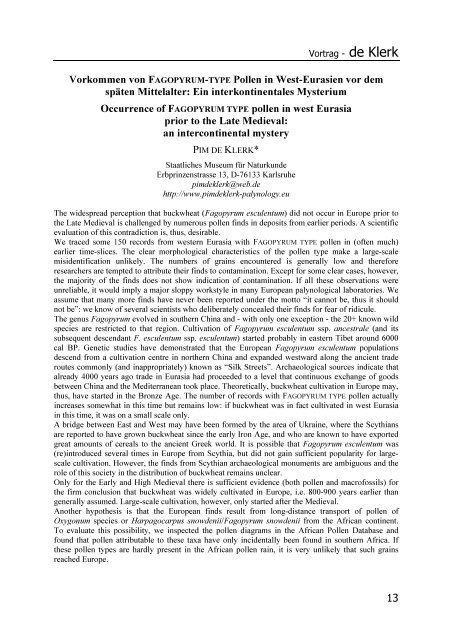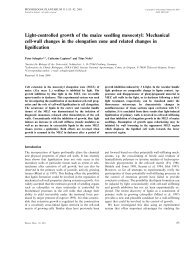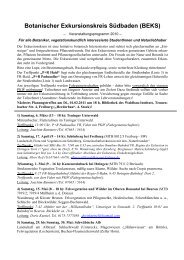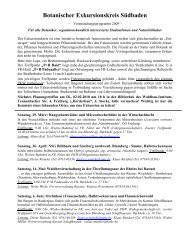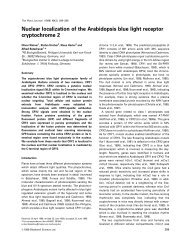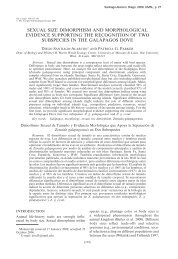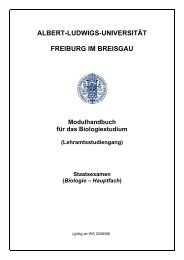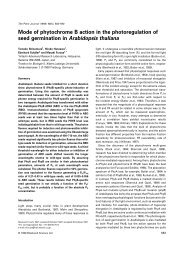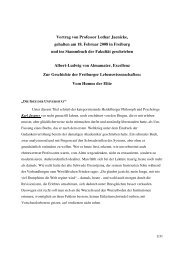download - Fakultät für Biologie - Albert-Ludwigs-Universität Freiburg
download - Fakultät für Biologie - Albert-Ludwigs-Universität Freiburg
download - Fakultät für Biologie - Albert-Ludwigs-Universität Freiburg
Sie wollen auch ein ePaper? Erhöhen Sie die Reichweite Ihrer Titel.
YUMPU macht aus Druck-PDFs automatisch weboptimierte ePaper, die Google liebt.
Vortrag - de Klerk<br />
Vorkommen von FAGOPYRUM-TYPE Pollen in West-Eurasien vor dem<br />
späten Mittelalter: Ein interkontinentales Mysterium<br />
Occurrence of FAGOPYRUM TYPE pollen in west Eurasia<br />
prior to the Late Medieval:<br />
an intercontinental mystery<br />
PIM DE KLERK*<br />
Staatliches Museum <strong>für</strong> Naturkunde<br />
Erbprinzenstrasse 13, D-76133 Karlsruhe<br />
pimdeklerk@web.de<br />
http://www.pimdeklerk-palynology.eu<br />
The widespread perception that buckwheat (Fagopyrum esculentum) did not occur in Europe prior to<br />
the Late Medieval is challenged by numerous pollen finds in deposits from earlier periods. A scientific<br />
evaluation of this contradiction is, thus, desirable.<br />
We traced some 150 records from western Eurasia with FAGOPYRUM TYPE pollen in (often much)<br />
earlier time-slices. The clear morphological characteristics of the pollen type make a large-scale<br />
misidentification unlikely. The numbers of grains encountered is generally low and therefore<br />
researchers are tempted to attribute their finds to contamination. Except for some clear cases, however,<br />
the majority of the finds does not show indication of contamination. If all these observations were<br />
unreliable, it would imply a major sloppy workstyle in many European palynological laboratories. We<br />
assume that many more finds have never been reported under the motto “it cannot be, thus it should<br />
not be”: we know of several scientists who deliberately concealed their finds for fear of ridicule.<br />
The genus Fagopyrum evolved in southern China and - with only one exception - the 20+ known wild<br />
species are restricted to that region. Cultivation of Fagopyrum esculentum ssp. ancestrale (and its<br />
subsequent descendant F. esculentum ssp. esculentum) started probably in eastern Tibet around 6000<br />
cal BP. Genetic studies have demonstrated that the European Fagopyrum esculentum populations<br />
descend from a cultivation centre in northern China and expanded westward along the ancient trade<br />
routes commonly (and inappropriately) known as “Silk Streets”. Archaeological sources indicate that<br />
already 4000 years ago trade in Eurasia had proceeded to a level that continuous exchange of goods<br />
between China and the Mediterranean took place. Theoretically, buckwheat cultivation in Europe may,<br />
thus, have started in the Bronze Age. The number of records with FAGOPYRUM TYPE pollen actually<br />
increases somewhat in this time but remains low: if buckwheat was in fact cultivated in west Eurasia<br />
in this time, it was on a small scale only.<br />
A bridge between East and West may have been formed by the area of Ukraine, where the Scythians<br />
are reported to have grown buckwheat since the early Iron Age, and who are known to have exported<br />
great amounts of cereals to the ancient Greek world. It is possible that Fagopyrum esculentum was<br />
(re)introduced several times in Europe from Scythia, but did not gain sufficient popularity for largescale<br />
cultivation. However, the finds from Scythian archaeological monuments are ambiguous and the<br />
role of this society in the distribution of buckwheat remains unclear.<br />
Only for the Early and High Medieval there is sufficient evidence (both pollen and macrofossils) for<br />
the firm conclusion that buckwheat was widely cultivated in Europe, i.e. 800-900 years earlier than<br />
generally assumed. Large-scale cultivation, however, only started after the Medieval.<br />
Another hypothesis is that the European finds result from long-distance transport of pollen of<br />
Oxygonum species or Harpagocarpus snowdenii/Fagopyrum snowdenii from the African continent.<br />
To evaluate this possibility, we inspected the pollen diagrams in the African Pollen Database and<br />
found that pollen attributable to these taxa have only incidentally been found in southern Africa. If<br />
these pollen types are hardly present in the African pollen rain, it is very unlikely that such grains<br />
reached Europe.<br />
13


